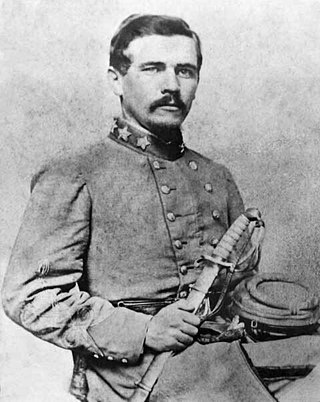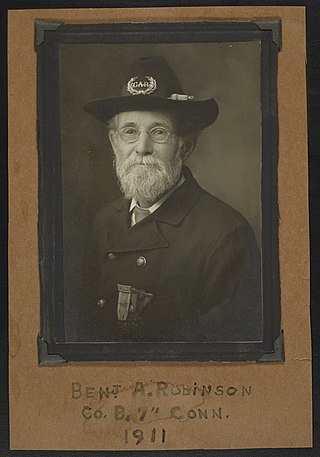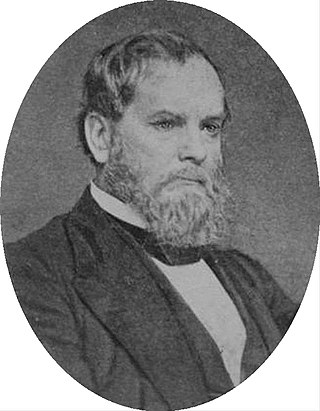
The Second Battle of Fort Wagner, also known as the Second Assault on Morris Island or the Battle of Fort Wagner, Morris Island, was fought on July 18, 1863, during the American Civil War. Union Army troops commanded by Brig. Gen. Quincy Gillmore launched an unsuccessful assault on the Confederate fortress of Fort Wagner, which protected Morris Island, south of Charleston Harbor. The battle occurred one week after the First Battle of Fort Wagner. Although it was a Confederate victory, the valor of the Black Union soldiers was widely praised. This had long-term strategic benefits by encouraging more African-Americans to enlist, allowing the Union to utilize a manpower resource that the Confederacy could not match for the remainder of the war.

Hampton's Legion was an American Civil War military unit of the Confederate States of America, organized and partially financed by wealthy South Carolina planter Wade Hampton III. Initially composed of infantry, cavalry, and artillery battalions, elements of Hampton's Legion participated in virtually every major campaign in the Eastern Theater, from the first to the last battle.

Edward Lloyd Thomas was a Confederate brigadier general of infantry during the American Civil War from the state of Georgia. He was colonel of the 35th Georgia Infantry Regiment, assigned to Joseph R. Anderson's brigade, which became part of A.P. Hill's famed "Light Division". When Anderson left to take control of the Tredegar Iron Works in Richmond, Thomas was promoted to brigadier general to command the brigade. He retained this position for the rest of the war and was present at all of the major battles of the Army of Northern Virginia.

Micah Jenkins was a Confederate general in the American Civil War, mortally wounded by friendly fire at the Battle of the Wilderness.

John Milton Brannan was an American military officer who served with distinction in the Mexican–American War as a United States Army artillery officer and as a Union Army brigadier general of United States Volunteers in the American Civil War. Brannan held command of the Department of Key West at Fort Zachary Taylor, Florida, part of the Union effort to hold federal installations within Confederate territories early in the war. Later, and most notably, he served as a division commander of the Union XIV Corps at the Battle of Chickamauga in 1863.

George Burgwyn Anderson was a Confederate military officer, serving first in the antebellum U.S. Army and then dying from wounds inflicted during the American Civil War while a general officer in the Confederate Army. He was among six generals killed or mortally wounded at the Battle of Antietam in September 1862.
The 50th Ohio Infantry Regiment was an infantry regiment in the Union Army during the American Civil War.

The 7th Connecticut Infantry Regiment was an infantry regiment that served in the Union Army during the American Civil War. Because it was in the same brigade as the 7th New Hampshire Volunteer Regiment, both regiments were often jointly called the '77th New England'.
The 62nd Ohio Infantry Regiment was an infantry regiment in the Union Army during the American Civil War.

The 68th Ohio Infantry Regiment was an infantry regiment in the Union Army during the American Civil War.
The 4th New Hampshire Infantry Regiment was an infantry regiment that served in the Union Army during the American Civil War.

Adley Hogan Gladden was lieutenant colonel and second commander of the Palmetto Regiment of South Carolina volunteers during the Mexican–American War and a brigadier general in the Confederate States Army during the American Civil War. He impressed General Braxton Bragg after defending Pensacola from Union Army bombardment and after a brief assignment at Mobile, Alabama, he was brought to Corinth, Mississippi, to command a brigade in the Army of Mississippi. He was mortally wounded at the Battle of Shiloh.

William Stephen Walker was a Confederate States Army brigadier general during the American Civil War. He was born in Pittsburgh, Pennsylvania, but was raised by Robert J. Walker, his uncle, who was a Secretary of the Treasury and U.S. Senator. Walker served as a first lieutenant in the United States Army during the Mexican–American War from 1847 to 1848. He was discharged in 1848. Walker rejoined the army as captain in the 1st U.S. Cavalry Regiment on March 3, 1855, and served until he resigned on May 1, 1861. Walker was wounded in the left arm and lost his left foot during the Battle of Ware Bottom Church during the Overland Campaign. After the war, he lived at Atlanta, Georgia.

The Second Battle of Pocotaligo, or Battle of Pocotaligo Bridge, or Battle of Yemassee, often referred to as simply the Battle of Pocotaligo, took place during the American Civil War on October 22, 1862 near Yemassee, South Carolina.
The 6th Connecticut Infantry Regiment was an infantry regiment that served in the Union Army during the American Civil War.
The First Battle of Pocotaligo was a battle in the American Civil War fought on May 29, 1862 near Yemassee, South Carolina. The Union objective was to sever the Charleston and Savannah Railroad and thus isolate Charleston, South Carolina.

The 76th Pennsylvania Volunteer Infantry was an infantry regiment that served in the Union Army during the American Civil War.

3rd Rhode Island Heavy Artillery Regiment was a heavy artillery regiment that served in the Union Army during the American Civil War.

The 50th Regiment Pennsylvania Volunteer Infantry was an infantry regiment that served in the Union Army during the American Civil War.

The 1st Connecticut Light Artillery Battery, recruited from the state of Connecticut, served in the Union Army between October 26, 1861, and June 11, 1865, during the American Civil War.
















